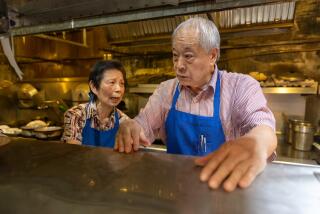Cultural Pride Isn’t Just a Facade
Qi Pang and his wife know what it’s like to struggle as immigrants. The artists moved to Southern California from a small Chinese province with their son in 2000, speaking only a few words of English.
When Ventura’s Chinese American historical society asked them earlier this year to paint a mural depicting the lives of the city’s first Chinese immigrants, they believed they were more than suited to the task.
In recent weeks, Qi Pang and his wife, Guo Song Yun, respected artists from the Jilin province in China, have been working to transform a wall in Figueroa Street’s historic China Alley into a memorial honoring Ventura’s Chinese pioneers. The city’s first Chinese immigrants, who numbered a few hundred at their peak, settled along Figueroa in 1865.
There, they developed a community of homes and businesses working as artisans, vegetable gardeners and fishermen. They opened grocery stores, barbershops and even established a fire crew to serve China Alley.
They also built roads, waterways, irrigation systems and railroads for the developing county. Merchants exported their wares and imported spices and canned goods from China.
“They were really a great force in building Ventura from the ground up,” said George Yu, president of the Ventura County Chinese American Historical Society, which is jointly funding the $16,000 mural with the city.
By the turn of the 19th century, however, the alley community began disintegrating with stringent immigration laws and widespread anti-Chinese sentiment.
Now, Qi Pang and Guo Song Yun are trying to capture the legacy of those pioneers.
Commissioned by Ventura and the historical society, the artists draw inspiration from historic photographs and papers documenting the immigrants’ lives.
The final project, scheduled for completion this month, will depict a vibrant community of people working and going about their daily lives against a backdrop of homes and businesses.
“It will mean a lot to the city in helping us interpret the Chinese contribution to our past,” city historian Richard Senate said of the project. “No marker has recognized their contribution and this will, of course, fill that void.”
Qi Pang, who began studying oil painting in China when he was 7, said through a translator that he was excited to be asked to honor the area’s Chinese population. The historical society asked the couple, who have painted murals in China, to paint the Ventura mural after a member saw their work at a Los Angeles exhibit.
“We were very excited and very touched because we could do something for the Chinese people who worked here and contributed here,” Qi Pang said.
More to Read
Sign up for Essential California
The most important California stories and recommendations in your inbox every morning.
You may occasionally receive promotional content from the Los Angeles Times.









